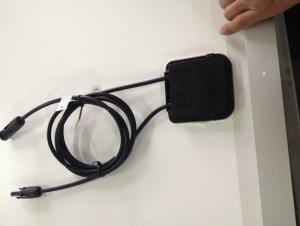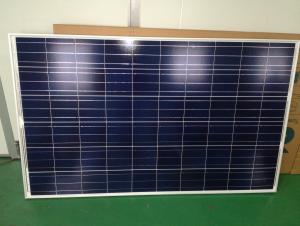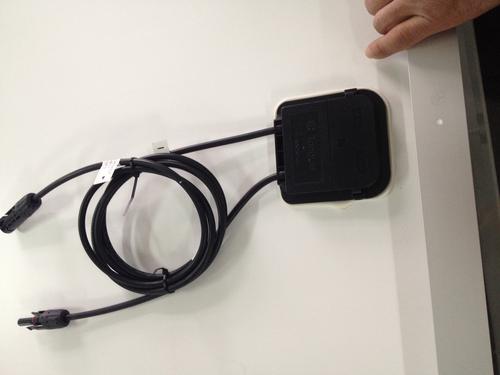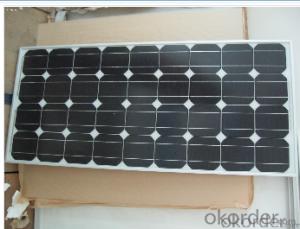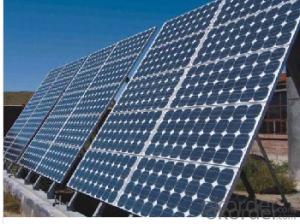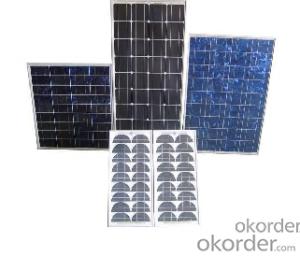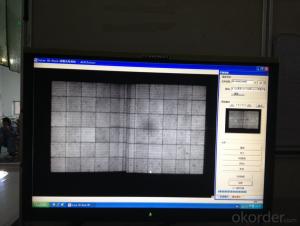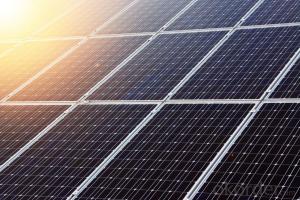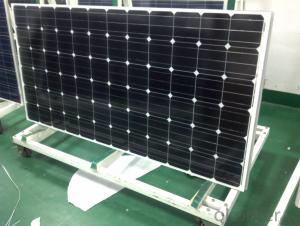Solar Panels for An Rv - Polycrystalline Solar Panels 30W for Small Solar Systems
- Loading Port:
- Shanghai
- Payment Terms:
- TT OR LC
- Min Order Qty:
- 10000 watt
- Supply Capability:
- 50000000 watt/month
OKorder Service Pledge
OKorder Financial Service
You Might Also Like
Product Description of Solar Polycrystalline Series Panels
Introduction of our company
Passionate about Innovation, Quality and Customer Service
We are world-leading manufacturer with high-performance solar power products that convert sunlight into electricity for residential, commercial, and utility-scale power generation. Our company is committed to develop and provide the world with clean and renewable energy to ease energy shortages as well as human kind’s impact on the environment.
We was founded on May 18, 2005, and was publicly listed on NASDAQ . By 2010, we had firmly established itself as the world’s leader in solar cell production and shipments. Our company shipped 1.7 GW over the course of 2012, an increase of 0.4% from the 1.69 GW shipped in 2011.
Characteristics of Polycrystalline Solar Panels
I Solar Cell : High efficiency crystalline solar cell. Even if under the weak light, the solar module can produce maximum power output.
II Tempered glass (toughened glass): Anti-reflecting coating and high transmission rate glass increase the power output and mechanical strength of solar module.
III EVA and TPT: Using high quality EVA and TPT to prevent destroying and water.
IV AI frame: Without screw, corner connection. 6 holes on the frame can be installed easily.
V Junction box: Multi function junction box with water proof.
VI Long lifetime: ≥25 years; Less power decrease
VII Good performance of preventing from atrocious weather such as wind and hails.
VIII Resisting moisture and etching effectively, not effected by geology.
Standard Test Conditions of Polycrystalline Solar Panels
The opto-electrical specifications shown below are stabilized values being measured at Standard Test Conditions, Irradiance: 1000W/m2, Spectrum: AM1.5 at 25°C, The info below is subject to manufacturing tolerances. Where appropriate minutes of measurement are available and are used for the dimensioning of the installation.
Advantages of Polycrystalline Solar Panels
1.High reliability with guaranteed -3% to +5% power output tolerance, ensuring return on investment
2. High conversion efficiency based on leading innovative photovoltaic technologies
3. Withstands high wind-pressure and snow load, and extreme temperature variations
4. Attractive appearance Unique frame design, high mechanical strength, and easy Installation
Characteristics of Polycrystalline Solar Panels
Max Power Voltage Vmp (V) | 17.6V | 17.4 V |
Max Power Current Imp (A) | 1.70A | 2.30A |
Open Circuit Voltage Voc (V) | 22.6V | 22.4V |
Short Circuit Current Isc (A) | 1.82A | 2.46A |
Max Power Pm (W) | 30W | 40W |
Temperature Coefficient of Cells
NOCT | 47℃±2℃ |
Temperature Coefficients of Isc (%/℃) | 0.06 |
Temperature Coefficients of Voc (%/℃) | -0.33 |
Temperature Coefficients of Pmp (%/℃) | -0.45 |
Mechanical Data Solar Polycrystalline Series
Power | 30W/10W |
Dimension | 510×450×25mm/610×510×30mm |
Weight | 4.5 kg |
Tolerance | ±3% |
The dimension of the modules can be changed according to the demand of clients Limits.
Operating Temperature | –45 °C to +80°C |
Storage Temperature | –45 °C to +80°C |
Max System Voltage | 700V |
Guarantee Solar Polycrystalline Series Panels
Products Guarantee | 2 years free from defects in materials and workmanship |
Performance Guarantee | No less than 90% within 10yrs and no less than 80% within 25yrs |
Certificates | IEC, ISO, TUV, CE |
Dimension of Solar Polycrystalline Series Panels

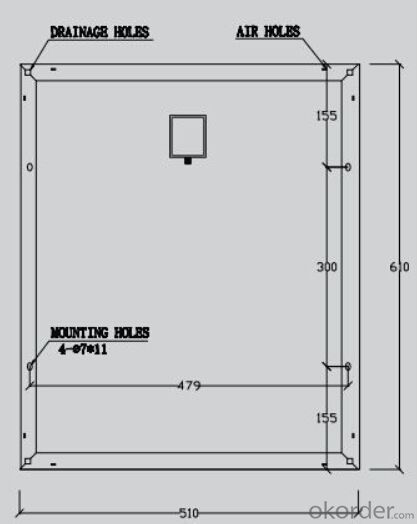
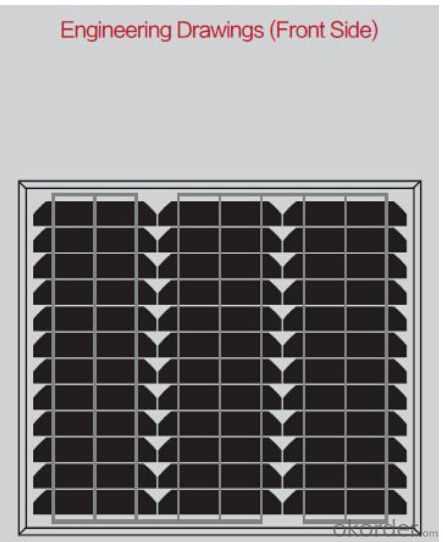
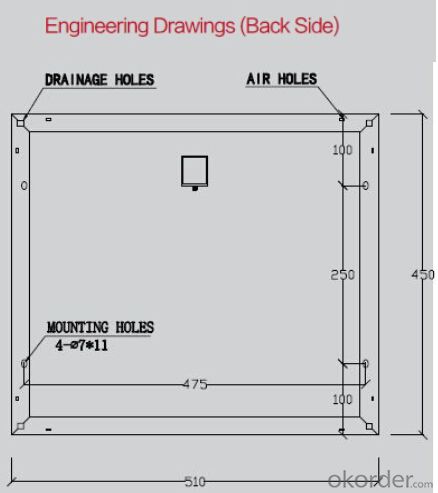
FAQ
We have organized several common questions for our clients,may help you sincerely:
1. What’s price per watt?
A: It’s depends on the quantity, delivery date and payment terms of the order. We can talk further about the detail price issue. Our products is high quality with lower price level.
2. Can you tell me the parameter of your solar panels?
We have different series of cells with different power output, both from c-si to a-si. Please take our specification sheet for your reference.
3. How do you pack your products?
We have rich experience on how to pack the panels to make sure the safety on shipment when it arrives at the destination.
4. What is your warranty system?
Our product performance guarantees for 25 years
• 12 years guarantee for workmanship
• Timeliness of delivery
• Quality Products certified (TÜV, UL, CE, ISO)
5. How do you pack your products?
We have rich experience on how to pack the panels to make sure the safety on shipment when it arrives at the destination.
- Q: will at least consider them for their home electricity? I've seen several articles that new technologies are now being used, but it doesn't seem to be promoted to residential apps. I've even seen that the solar technology will be used in paints in the near future.
- Solar panels are cost effective if they are used over their payback period. The problem is that the down payment is expensive, and the payback period is maybe 0-20 years, so very few people actually expect to own their homes for 0-20 years. It also only really makes sense in areas that buy back electricity generated during the day when you're not using it. In Germany and other european countries, power companies are required to buy back electricity at a higher price than they sell it for--this reduces the payback period and is a great incentive for solar panels. For this reason, they are much more popular over there. Given a little time for the price to fall and given some change in energy policy, solar panels will become more cost effective in the future. Depends on who gets elected, though. There is a solution to the payback period problem, though. Rather than homeowners taking on the long payback period in homes they may not own long enough, some companies are buying panels and leasing them to homeowners. In exchange, homeowners get reduced electric bills, that pay off the lease payments, plus a little extra. I think this is the way to go. check out the link below.
- Q: How do solar panels affect the overall comfort of a building?
- Solar panels can positively impact the overall comfort of a building by reducing energy costs and providing a sustainable source of power. By generating electricity from sunlight, solar panels can help to offset the use of traditional fossil fuel-based energy sources, resulting in lower electricity bills. Additionally, solar panels can reduce reliance on the electrical grid, ensuring a more reliable power supply and minimizing the impact of power outages. This increased energy efficiency can contribute to a more comfortable indoor environment by helping to regulate temperature and reduce the need for heating or cooling systems.
- Q: Can solar panels be installed on rooftop gardens or green roofs?
- Yes, solar panels can be installed on rooftop gardens or green roofs. In fact, these types of roofs provide an ideal space for solar panel installation as they often have ample sunlight exposure and can help optimize energy efficiency of the building. Additionally, solar panels on rooftop gardens or green roofs can contribute to a more sustainable and eco-friendly environment by combining renewable energy generation with green infrastructure.
- Q: Can solar panels be installed on bus stops or shelters?
- Yes, solar panels can be installed on bus stops or shelters. This allows them to generate electricity from sunlight, which can be used to power lighting, signage, and other amenities at the bus stops or shelters. It also helps in reducing reliance on grid electricity and promotes the use of renewable energy sources.
- Q: I am in the market for buying a home. There is one for salke that actually has solar panels on top. How are they used? Do you need to pay for gas and electric still. Does it really light up the house and keep it warm. WHat about the AC keeping hte house cool in the summer does it work for that too? Please explain in solar for dummy terms. I haveno clue about solar panels other thatn the fact that it needs sunlight to run.
- I think that rustoria67 bumped his head on some thing. There are thousands of homes using only solar panels to power their homes, and it no way near an acre of them. With the right setup Kw of panels will work. Remember one can't bring a boat to an airplane race and hope to win. Look at this link.
- Q: Can solar panels be used to power a military base?
- Yes, solar panels can be used to power a military base. Solar power is a clean and renewable energy source that can be harnessed to generate electricity for various purposes, including powering military installations. Implementing solar panels on military bases can help reduce reliance on traditional fossil fuels, increase energy independence, and contribute to a more sustainable and environmentally friendly operation of the base.
- Q: Are there solar panel systems that I can plug directly into my house to help reduce my electricity bill? If so, are they very expensive? Any help would be greatly appreciated!
- As per the question, the answer is no. Solar panels are available, they are expensive, they can reduce your energy bill, you can get up to 30% of the expense back from your taxes, but they must be installed by a qualified electrician or solar panel installer to work properly.
- Q: Can solar panels be installed on boats or RVs?
- Yes, solar panels can be installed on boats or RVs. In fact, it is quite common to see solar panels being used as a source of renewable energy in these mobile settings. Solar panels can provide a reliable and sustainable power solution for charging batteries and running various electrical appliances on boats and RVs.
- Q: What is the impact of roof shading on solar panels' efficiency?
- Roof shading has a significant impact on the efficiency of solar panels. When a roof is shaded, whether by nearby trees, buildings, or other obstructions, it reduces the amount of sunlight reaching the panels. This shading creates areas of lower or no sunlight, resulting in decreased energy production. Therefore, minimizing roof shading is crucial to maximize the efficiency and overall performance of solar panels.
- Q: Can solar panels be installed on flat roofs?
- Yes, solar panels can be installed on flat roofs. In fact, flat roofs are often well-suited for solar panel installations due to their large surface area and easy accessibility. Mounting systems can be used to position the panels at an optimal angle for maximum sunlight exposure.
Send your message to us
Solar Panels for An Rv - Polycrystalline Solar Panels 30W for Small Solar Systems
- Loading Port:
- Shanghai
- Payment Terms:
- TT OR LC
- Min Order Qty:
- 10000 watt
- Supply Capability:
- 50000000 watt/month
OKorder Service Pledge
OKorder Financial Service
Similar products
Hot products
Hot Searches
Related keywords
